 |
Home | Charity | Feedback |
Laos:
Luang Prabang,
Vientiane
Luang Prabang, Laos: Heart of Laotian culture by Prakash Bang, Editor in Chief 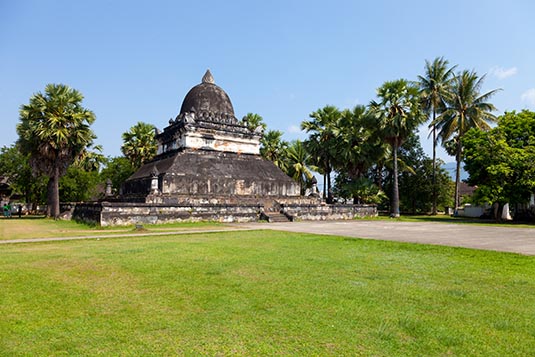 The ancient town of Luang Prabang situated in northern Laos, was designated a UNESCO World Heritage Site in 1995. Considered by many travelers and writers as being the heart of Laotian culture, the tiny town is encircled by mountains and is 700 metres above sea level at the confluence of the Nam Khan and Mekong Rivers. 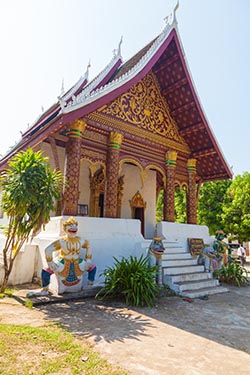 Luang Prabang was the ancient royal capital of the Lan Xang Kingdom until King Phothisarat moved the administrative seat to Vientiane in 1545. Regardless, it has continued to overlook Vientiane as the destination of choice with its amalgamation of crumbling French architecture, glistening temples and extensive natural beauty. The town's entire historical section is dedicated to tourism, with everything from former royal palaces to over 33 Wats (temples), on the tourist trail. This former Royal capital still remains the main centre for Buddhist learning in Laos and is the perfect location for spiritual contemplation.
Luang Prabang was the ancient royal capital of the Lan Xang Kingdom until King Phothisarat moved the administrative seat to Vientiane in 1545. Regardless, it has continued to overlook Vientiane as the destination of choice with its amalgamation of crumbling French architecture, glistening temples and extensive natural beauty. The town's entire historical section is dedicated to tourism, with everything from former royal palaces to over 33 Wats (temples), on the tourist trail. This former Royal capital still remains the main centre for Buddhist learning in Laos and is the perfect location for spiritual contemplation.
Cascading waterfalls, scaling peaks and the milky-brown waters of the Mekong River provide ample opportunity to swim, climb and sail your way through Luang Prabang. It is only as recent as 1989 that Laos opened up to tourism and the country that had previously been cut off from the rest of Southeast Asia developed a small but steady economy, based on tourism and regional trade. We landed in Luang Prabang at around noon. For the 2 nights that we would be there, our home was Kiridara Resort, built on a hill slope using traditional wooden architecture. The afternoon was spent visiting few of the many wats in town. 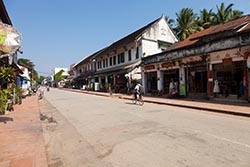 Wat Visounnalat was originally built during the reign of King Wisunarat in 1513 and represents the earliest style, sometimes referred to as Luang Prabang Style I, of Lao temple architecture. Wat Wisunalat is Luang Prabang’s oldest operating temple. As with the sims of most Lao wats, there are multiple roof structures. Located and adjoining Wat Aham to the southeast, it was probably built on the rice fields of the guardian spirits of the city (devata luang), Pu No and Na No. The sacred Prabang image was housed in the sim from 1513 until it was taken to Vientiane in 1707.
Wat Visounnalat was originally built during the reign of King Wisunarat in 1513 and represents the earliest style, sometimes referred to as Luang Prabang Style I, of Lao temple architecture. Wat Wisunalat is Luang Prabang’s oldest operating temple. As with the sims of most Lao wats, there are multiple roof structures. Located and adjoining Wat Aham to the southeast, it was probably built on the rice fields of the guardian spirits of the city (devata luang), Pu No and Na No. The sacred Prabang image was housed in the sim from 1513 until it was taken to Vientiane in 1707.
The original highly ornate wooden sim was a spectacular example of Lao craftsmanship at its finest and was one of the most imposing religious structures of old Luang Prabang. It had a double roof with the upper roof raised high above the lower roof. Much of the sim and the city were destroyed during the invasion of the Chinese Haw Black Flags marauders in 1887. The sim was rebuilt between 1896 and 1898 and during the reign of King Sakkarin Kamsuk. 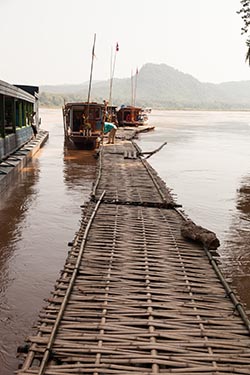 Another important and prominent feature of the wat is its unique That Pathoum, or Stupa of the Great Lotus, in the front and northeastern side of the sim. It is known more popularly as That Makmo, the "Watermelon Stupa" because of its rounded dome. The dome stylistically reflects a Sinhalese influence and is the only stupa of such a shape in Laos, and perhaps even in Cambodia or Vietnam. Originally erected between 1514 and 1515, it was destroyed during the Haw Black Flag incursion in 1887. Inside were numerous ancient Buddha images. Many were destroyed; a number are in the National Palace Museum, and some are in the sim itself. Its reconstruction was not seriously undertaken until the late 1920s, over thirty years after the reconstruction of the sim, and was completed in 1932. The stupa sets on a number of different square tiers and has a Lao-Buddhist style Usnisa crown at its top.
Another important and prominent feature of the wat is its unique That Pathoum, or Stupa of the Great Lotus, in the front and northeastern side of the sim. It is known more popularly as That Makmo, the "Watermelon Stupa" because of its rounded dome. The dome stylistically reflects a Sinhalese influence and is the only stupa of such a shape in Laos, and perhaps even in Cambodia or Vietnam. Originally erected between 1514 and 1515, it was destroyed during the Haw Black Flag incursion in 1887. Inside were numerous ancient Buddha images. Many were destroyed; a number are in the National Palace Museum, and some are in the sim itself. Its reconstruction was not seriously undertaken until the late 1920s, over thirty years after the reconstruction of the sim, and was completed in 1932. The stupa sets on a number of different square tiers and has a Lao-Buddhist style Usnisa crown at its top.
Next on the list was Wat Sensoukharam also known as Wat Sen. It was built in 1718 by Chao Ta Rang during the reign of the king Kitsarath. The name literally means 'Temple of 100,000 Treasures' since it was originally built using 100,000 stones from the nearby Mekong River. The temple consists of many enclosures including the main temple; room for secondary assemblies; stupas; living quarters and a drum shelter. 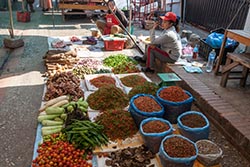 Wat Sen is located in the Old Quarter that gave us an opportunity to walk the streets before heading to Wat Mai Suwannaphumaham.
Wat Sen is located in the Old Quarter that gave us an opportunity to walk the streets before heading to Wat Mai Suwannaphumaham.
The impressive Wat Mai Suwannaphumaham is one of Luang Prabang’s largest and most richly decorated temples. Both its interior and exterior are extensively adorned with black and red lacquer decoration and gold leaf. The temple, also known as Wat Mai, meaning “new temple” was founded around 1780 by King Anurat of the Luang Prabang Kingdom. Located next to the Royal Palace, the Wat Mai was the temple used by Laos Royalty. It is one of the few temples that survived the destruction by Chinese invaders in 1887. 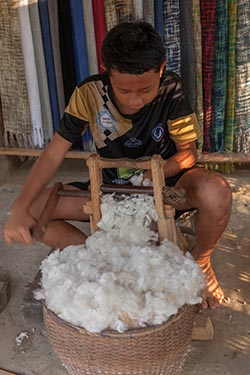 After much of Luang Prabang and most of its temples were destroyed by Chinese invaders in 1887 the Wat Mai, which was spared the destruction, became the new home of the Phra Bang Buddha image. The Phra Bang, Laos’ most highly venerated Buddha image, stayed there until halfway of the 20th century, when it was moved to its current location in the Royal Palace Museum. During Laos New Year celebrations the image is brought in procession to the Wat Mai temple for ceremonial cleansing.
After much of Luang Prabang and most of its temples were destroyed by Chinese invaders in 1887 the Wat Mai, which was spared the destruction, became the new home of the Phra Bang Buddha image. The Phra Bang, Laos’ most highly venerated Buddha image, stayed there until halfway of the 20th century, when it was moved to its current location in the Royal Palace Museum. During Laos New Year celebrations the image is brought in procession to the Wat Mai temple for ceremonial cleansing.
The Wat Mai’s most impressive structure is the sim. Its five tiered roof extending almost to the ground is adorned with golden Naga finials. At the center of the highest tier is a “Dok so faa” consisting of three golden parasols. On either side of the sim is a veranda, the main one being particularly beautiful. Its façade contains very intricate gilded stucco bas reliefs made in the 1960’s. The reliefs depict scenes from the Ramayana and the Jatakas and scenes of everyday life in Luang Prabang with temples, animals, houses, festivities and dancing women. 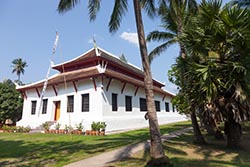 The veranda’s roof is supported by large black and gold stenciled columns topped with capitals in the shape of lotus leafs. The sim’s doors are decorated with gilded carvings of deities and flower motifs.
The veranda’s roof is supported by large black and gold stenciled columns topped with capitals in the shape of lotus leafs. The sim’s doors are decorated with gilded carvings of deities and flower motifs.
The sim houses the Wat Mai’s principal Buddha image, a large gilded seated Buddha image in the meditation position. It is surrounded by a large number of smaller images in various mudras. A shrine houses an emerald Buddha image. The original, the most highly venerated Buddha image in Thailand, is enshrined in the Wat Phra Kaew temple on the grounds of the Grand Palace in Bangkok. 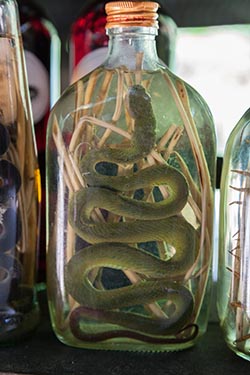 In the evening, we visited Luang Prabang’s famous night market. One of the main road is closed for traffic and local vendors take over. They lay their merchandise on the street and sell them under battery lights. A good place to look for souvenirs and street food.
In the evening, we visited Luang Prabang’s famous night market. One of the main road is closed for traffic and local vendors take over. They lay their merchandise on the street and sell them under battery lights. A good place to look for souvenirs and street food.
The next morning we walked to one of the many piers on the banks of River Mekong to take our private boat to Pak-Ou Caves. To reach the pier we made our way through the busy morning market. Upstream it took us about 90 minutes to reach the base of the caves. One of the most respected holy sites in Laos; Pak Ou Caves have a history dating back thousands of years. Packed with over 4,000 Buddha icons, the caves, a shrine to the river spirit and Lord Buddha, are set in a dramatic limestone cliff at the point where the Mekong joins the Nam Ou River. There are two caves to visit, the lower cave called Tham Ting and the upper cave Tham Theung, both boasting miniature Buddhist figures that are mostly made from wood. Positioned about 50 feet above the river, Tham Ting filters in some light but a torch is required for the absolutely pitch black Tham Theung. The upper cave is home to the majority of the Buddha statues and you will need to find your way in darkness to the thousands of hidden icons. The statues are believed to have been left in the caves by local people for hundreds of years. 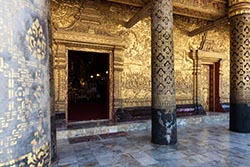 Pak Ou translates to ‘mouth of the Ou River’ with the first cave entrance of Tham Ting being very visible from the water; the higher cave is accessed by stairs. The Buddha images in the Pak Ou Caves assume a variety of positions, from meditation to peace and nirvana (the reclining Buddha). Both caves are shrines to Buddha, offering places of worship with the largest image in Tham Ting being a popular place to burn incense and offer prayers. The smaller cave is the more peaceful, with glimpses of the Mekong providing a breathtaking backdrop. The caves are a very popular pilgrim site for locals and get very busy during April when the Lao New Year is in full swing with locals washing and attending to the images.
Pak Ou translates to ‘mouth of the Ou River’ with the first cave entrance of Tham Ting being very visible from the water; the higher cave is accessed by stairs. The Buddha images in the Pak Ou Caves assume a variety of positions, from meditation to peace and nirvana (the reclining Buddha). Both caves are shrines to Buddha, offering places of worship with the largest image in Tham Ting being a popular place to burn incense and offer prayers. The smaller cave is the more peaceful, with glimpses of the Mekong providing a breathtaking backdrop. The caves are a very popular pilgrim site for locals and get very busy during April when the Lao New Year is in full swing with locals washing and attending to the images.
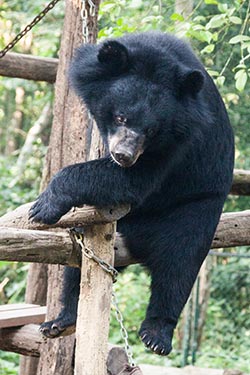 The caves are not far from Ban Xang Hai village, famous for its wine production and for the making of Lao wine earthen jars and colourful clothing weaved on handlooms. On our way back, we made a brief stop at the village.
The caves are not far from Ban Xang Hai village, famous for its wine production and for the making of Lao wine earthen jars and colourful clothing weaved on handlooms. On our way back, we made a brief stop at the village.
About 30 kilometers South of Luang Prabang are the Kuang Si falls, a beautiful 50 meter high waterfall and a group of turquoise pools set in the tropical rain forest. The falls, locally called Tat Kuang Si are well visited by tourists and locals alike. We were dropped at the base of the hill. From here, well maintained walkways and bridges lead into the tropical forest. You will be welcomed by a bear sanctuary and after a short hike you will get to a group of shallow pools, filled with turquoise waters. The pools are open to swimmers; the water is chilly providing a good chance to cool off from the heat of the country side. A beautiful hike upstream through the jungle leads to the main waterfall which is about 50 meters high. To the left of it is a trail to the top were our car was waiting to take us back to town. The trip from the falls to town is a very scenic ride passing through rice fields, local villages and green hills. The next morning we would leave for Chiang Mai in Thailand. Luang Prabang Image Gallery  Photo viewer Photo viewer
|
|
|
Home |
Charity |
Feedback
Privacy Policy | Terms of Usage © YoGoYo.com. All rights reserved. |



















































































